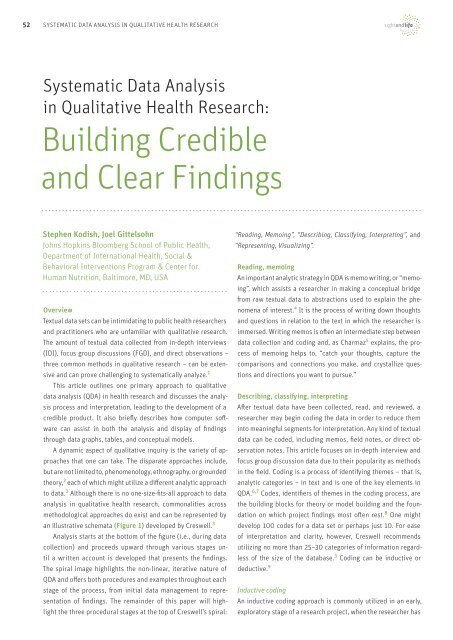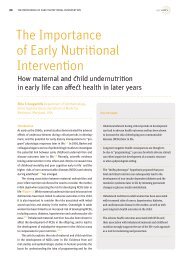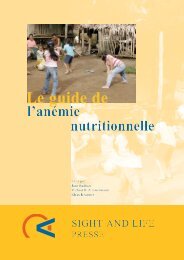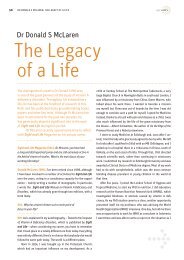Systematic Data Analysis in Qualitative Health ... - Sight and Life
Systematic Data Analysis in Qualitative Health ... - Sight and Life
Systematic Data Analysis in Qualitative Health ... - Sight and Life
You also want an ePaper? Increase the reach of your titles
YUMPU automatically turns print PDFs into web optimized ePapers that Google loves.
52 SYSTEMATIC DATA ANALYSIS IN QUALITATIVE HEALTH RESEARCH<br />
<strong>Systematic</strong> <strong>Data</strong> <strong>Analysis</strong><br />
<strong>in</strong> <strong>Qualitative</strong> <strong>Health</strong> Research:<br />
Build<strong>in</strong>g Credible<br />
<strong>and</strong> Clear F<strong>in</strong>d<strong>in</strong>gs<br />
Stephen Kodish, Joel Gittelsohn<br />
Johns Hopk<strong>in</strong>s Bloomberg School of Public <strong>Health</strong>,<br />
Department of International <strong>Health</strong>, Social &<br />
Behavioral Interventions Program & Center for<br />
Human Nutrition, Baltimore, MD, USA<br />
Overview<br />
Textual data sets can be <strong>in</strong>timidat<strong>in</strong>g to public health researchers<br />
<strong>and</strong> practitioners who are unfamiliar with qualitative research.<br />
The amount of textual data collected from <strong>in</strong>-depth <strong>in</strong>terviews<br />
(IDI), focus group discussions (FGD), <strong>and</strong> direct observations –<br />
three common methods <strong>in</strong> qualitative research – can be extensive<br />
<strong>and</strong> can prove challeng<strong>in</strong>g to systematically analyze. 1<br />
This article outl<strong>in</strong>es one primary approach to qualitative<br />
data analysis (QDA) <strong>in</strong> health research <strong>and</strong> discusses the analysis<br />
process <strong>and</strong> <strong>in</strong>terpretation, lead<strong>in</strong>g to the development of a<br />
credible product. It also briefly describes how computer software<br />
can assist <strong>in</strong> both the analysis <strong>and</strong> display of f<strong>in</strong>d<strong>in</strong>gs<br />
through data graphs, tables, <strong>and</strong> conceptual models.<br />
A dynamic aspect of qualitative <strong>in</strong>quiry is the variety of approaches<br />
that one can take. The disparate approaches <strong>in</strong>clude,<br />
but are not limited to, phenomenology, ethnography, or grounded<br />
theory, 2 each of which might utilize a different analytic approach<br />
to data. 3 Although there is no one-size-fits-all approach to data<br />
analysis <strong>in</strong> qualitative health research, commonalities across<br />
methodological approaches do exist <strong>and</strong> can be represented by<br />
an illustrative schemata (Figure 1) developed by Creswell. 3<br />
<strong>Analysis</strong> starts at the bottom of the figure (i.e., dur<strong>in</strong>g data<br />
collection) <strong>and</strong> proceeds upward through various stages until<br />
a written account is developed that presents the f<strong>in</strong>d<strong>in</strong>gs.<br />
The spiral image highlights the non-l<strong>in</strong>ear, iterative nature of<br />
QDA <strong>and</strong> offers both procedures <strong>and</strong> examples throughout each<br />
stage of the process, from <strong>in</strong>itial data management to representation<br />
of f<strong>in</strong>d<strong>in</strong>gs. The rema<strong>in</strong>der of this paper will highlight<br />
the three procedural stages at the top of Creswell’s spiral:<br />
“Read<strong>in</strong>g, Memo<strong>in</strong>g”, “Describ<strong>in</strong>g, Classify<strong>in</strong>g, Interpret<strong>in</strong>g”, <strong>and</strong><br />
“Represent<strong>in</strong>g, Visualiz<strong>in</strong>g”.<br />
Read<strong>in</strong>g, memo<strong>in</strong>g<br />
An important analytic strategy <strong>in</strong> QDA is memo writ<strong>in</strong>g, or “memo<strong>in</strong>g”,<br />
which assists a researcher <strong>in</strong> mak<strong>in</strong>g a conceptual bridge<br />
from raw textual data to abstractions used to expla<strong>in</strong> the phenomena<br />
of <strong>in</strong>terest. 4 It is the process of writ<strong>in</strong>g down thoughts<br />
<strong>and</strong> questions <strong>in</strong> relation to the text <strong>in</strong> which the researcher is<br />
immersed. Writ<strong>in</strong>g memos is often an <strong>in</strong>termediate step between<br />
data collection <strong>and</strong> cod<strong>in</strong>g <strong>and</strong>, as Charmaz 5 expla<strong>in</strong>s, the process<br />
of memo<strong>in</strong>g helps to, “catch your thoughts, capture the<br />
comparisons <strong>and</strong> connections you make, <strong>and</strong> crystallize questions<br />
<strong>and</strong> directions you want to pursue.”<br />
Describ<strong>in</strong>g, classify<strong>in</strong>g, <strong>in</strong>terpret<strong>in</strong>g<br />
After textual data have been collected, read, <strong>and</strong> reviewed, a<br />
researcher may beg<strong>in</strong> cod<strong>in</strong>g the data <strong>in</strong> order to reduce them<br />
<strong>in</strong>to mean<strong>in</strong>gful segments for <strong>in</strong>terpretation. Any k<strong>in</strong>d of textual<br />
data can be coded, <strong>in</strong>clud<strong>in</strong>g memos, field notes, or direct observation<br />
notes. This article focuses on <strong>in</strong>-depth <strong>in</strong>terview <strong>and</strong><br />
focus group discussion data due to their popularity as methods<br />
<strong>in</strong> the field. Cod<strong>in</strong>g is a process of identify<strong>in</strong>g themes – that is,<br />
analytic categories – <strong>in</strong> text <strong>and</strong> is one of the key elements <strong>in</strong><br />
QDA. 6,7 Codes, identifiers of themes <strong>in</strong> the cod<strong>in</strong>g process, are<br />
the build<strong>in</strong>g blocks for theory or model build<strong>in</strong>g <strong>and</strong> the foundation<br />
on which project f<strong>in</strong>d<strong>in</strong>gs most often rest. 8 One might<br />
develop 100 codes for a data set or perhaps just 10. For ease<br />
of <strong>in</strong>terpretation <strong>and</strong> clarity, however, Creswell recommends<br />
utiliz<strong>in</strong>g no more than 25–30 categories of <strong>in</strong>formation regardless<br />
of the size of the database. 3 Cod<strong>in</strong>g can be <strong>in</strong>ductive or<br />
deductive. 9<br />
Inductive cod<strong>in</strong>g<br />
An <strong>in</strong>ductive cod<strong>in</strong>g approach is commonly utilized <strong>in</strong> an early,<br />
exploratory stage of a research project, when the researcher has
SIGHT AND LIFE | VOL. 25 (2) | 2011 SYSTEMATIC DATA ANALYSIS IN QUALITATIVE HEALTH RESEARCH 53<br />
53<br />
figure 1: <strong>Data</strong> analysis spiral<br />
Procedures<br />
account<br />
Examples<br />
Represent<strong>in</strong>g,<br />
Visualiz<strong>in</strong>g<br />
Matrix, Trees,<br />
Propositions<br />
Describ<strong>in</strong>g,<br />
Classify<strong>in</strong>g,<br />
Interpret<strong>in</strong>g<br />
Context,<br />
Categories,<br />
Comparisons<br />
Read<strong>in</strong>g,<br />
Memo<strong>in</strong>g<br />
Reflect<strong>in</strong>g,<br />
Writ<strong>in</strong>g Notes,<br />
Across Questions<br />
<strong>Data</strong><br />
Manag<strong>in</strong>g<br />
Source: Creswell 3<br />
data<br />
collection<br />
(text, images)<br />
Files, Units,<br />
Organiz<strong>in</strong>g<br />
not formulated hypotheses, <strong>and</strong> is based on few (if any) preconceived<br />
notions of the f<strong>in</strong>al results. Plans for additional data<br />
collection are frequently the outcome of early cod<strong>in</strong>g with this<br />
exploratory approach.<br />
Consider, for <strong>in</strong>stance, a qualitative acceptability study of a<br />
specialized food commodity, such as a lipid-based nutrient supplement<br />
(LNS), perhaps Nutributter (Nutriset SAS, Malaunay,<br />
France). LNS conta<strong>in</strong><strong>in</strong>g energy, prote<strong>in</strong>, essential fatty acids,<br />
<strong>and</strong> micronutrients have been developed to overcome nutrient<br />
shortfalls <strong>in</strong> exist<strong>in</strong>g diets of young children 6–24 months. 10 Although<br />
Nutributter has been accepted by target populations<br />
<strong>in</strong> some sett<strong>in</strong>gs, 11 a researcher exam<strong>in</strong><strong>in</strong>g acceptability <strong>in</strong> a<br />
new sett<strong>in</strong>g us<strong>in</strong>g a qualitative approach might analyze <strong>in</strong>itial<br />
qualitative data us<strong>in</strong>g open cod<strong>in</strong>g; that is, he or she explores<br />
the textual data l<strong>in</strong>e-by-l<strong>in</strong>e for conceptualization of “emergent”<br />
themes related to beneficiary perceptions of the unfamiliar commodity.<br />
3,5 Themes from the data might emerge that are unexpected<br />
to the researcher, for example, unique cultural characteristics<br />
that directly relate to acceptability. In such a scenario,<br />
analysis us<strong>in</strong>g <strong>in</strong>ductive cod<strong>in</strong>g would be concurrent with data<br />
collection to shape future stages of the research project. New<br />
questions could be asked or additional methods added based on<br />
those emergent themes.<br />
figure 2: Visual representation of the theory<br />
of planned behavior<br />
Attitude<br />
Subjective<br />
Norms<br />
Perceived<br />
Behavioral<br />
Control<br />
Intention<br />
Behavior<br />
Source: Adapted from 12<br />
Deductive cod<strong>in</strong>g<br />
Deductive cod<strong>in</strong>g is oriented towards confirm<strong>in</strong>g or test<strong>in</strong>g the<br />
<strong>in</strong>vestigator’s preconceived terms <strong>and</strong> relationships. It is often<br />
based on a researcher’s a prior 4 (a Lat<strong>in</strong> term that refers to prior<br />
knowledge about a population) hypotheses <strong>and</strong> might utilize<br />
“prefigured” codes derived from a theoretical model or exist<strong>in</strong>g<br />
literature on the topic of <strong>in</strong>terest. 12,13 Us<strong>in</strong>g pre-determ<strong>in</strong>ed<br />
codes is popular <strong>in</strong> the health sciences – a field that utilizes<br />
many models to expla<strong>in</strong> health-seek<strong>in</strong>g behavior.<br />
As an example, consider the Theory of Planned Behavior (TPB)<br />
(Figure 2), which seeks to expla<strong>in</strong> why people perform certa<strong>in</strong><br />
actions 14,15 – for example adher<strong>in</strong>g to daily consumption of Nutributter.<br />
A researcher deductively analyz<strong>in</strong>g a textual data set<br />
would apply codes based on the TPB <strong>in</strong> relation to the major<br />
constructs of the theory: perceived behavioral control (PBC),
54 SYSTEMATIC DATA ANALYSIS IN QUALITATIVE HEALTH RESEARCH<br />
table 1: Excerpt of a codebook developed for <strong>in</strong>ductive QDA of data collected at Kakuma Refugee Camp, Kenya.<br />
Mnemonic or numeric “Brief” Code Full Description of Code When to use/not to use the code<br />
2.0 <strong>Life</strong> <strong>in</strong> Kakuma Refugee experiences resid<strong>in</strong>g <strong>in</strong> KRC Use this family of codes when the CL or MNP beneficiary<br />
discusses his or her life as a refugee at KRC.<br />
2.1 Hardship Hardships faced while liv<strong>in</strong>g <strong>in</strong> Kakuma, related to<br />
security, violence, tribalism, etc<br />
Use this code for the array of hardships refugees<br />
discuss at KRC unrelated to illness experiences.<br />
Illness is mentioned a lot but use 2.2.<br />
2.2 Illness Illness experiences of the <strong>in</strong>dividual or of his or her<br />
family <strong>and</strong>/or community<br />
Use this umbrella code for any health-related<br />
experience related to life <strong>in</strong> KRC. It can be related<br />
to anemia or another illness. Codes 2.2.1 <strong>and</strong> 2.2.2<br />
will be used to dist<strong>in</strong>guish between the types<br />
of illness discussed.<br />
2.2.1 Ill. Anemia Experiences with anemia or malnutrition, specifically Use this code for health-related experiences, <strong>in</strong><br />
particular those related to anemia <strong>and</strong>/or<br />
malnutrition. Also, “lack of blood” should be <strong>in</strong>cluded<br />
<strong>in</strong> this code as it’s referr<strong>in</strong>g to anemia.<br />
Source: Adapted from one of the authors’ projects<br />
attitude (ATT), subjective norm (SN), <strong>and</strong> <strong>in</strong>tention (INT). While<br />
exam<strong>in</strong><strong>in</strong>g texts, he or she would specifically look for themes <strong>in</strong><br />
relation to those constructs <strong>and</strong>, perhaps, ignore other topics unrelated<br />
to the theory. Creswell suggests, however, that researchers<br />
who employ this approach to analysis be open to additional<br />
codes emerg<strong>in</strong>g dur<strong>in</strong>g the analytic process, because us<strong>in</strong>g this<br />
table 2: Advantages <strong>and</strong> disadvantages of us<strong>in</strong>g computer software.<br />
Advantages<br />
Disadvantages<br />
1. Provides an organized storage file 1. Requires the researcher to learn<br />
system, especially large data sets how to use the software program,<br />
which can be very time consum<strong>in</strong>g<br />
2. Helps a researcher locate textual 2. Better programs may be<br />
material quickly<br />
cost prohibitive<br />
3. Creates visually <strong>in</strong>formative<br />
3. Distances the researcher<br />
schemata to illustrate f<strong>in</strong>d<strong>in</strong>gs<br />
from the data<br />
4. Provides time-sav<strong>in</strong>g functions 4. Makes analysis as a team<br />
(eg, quickly can determ<strong>in</strong>e<br />
challeng<strong>in</strong>g due to logistics beh<strong>in</strong>d<br />
frequencies of codes)<br />
shar<strong>in</strong>g files<br />
5. Allows for cod<strong>in</strong>g of not only text, 5. Nascent compared to<br />
but also images <strong>and</strong> video files quantitative software programs –<br />
can be frustrat<strong>in</strong>g to work with<br />
Content adapted from 3,8 <strong>and</strong> the authors’ experiences<br />
type of cod<strong>in</strong>g scheme may limit the analysis to the “prefigured”<br />
codes rather than open up the codes to reflect the views of participants<br />
from an emic perspective 3 <strong>and</strong>, consequently, may limit<br />
f<strong>in</strong>d<strong>in</strong>gs.<br />
Us<strong>in</strong>g a codebook<br />
In both deductive <strong>and</strong> <strong>in</strong>ductive cod<strong>in</strong>g, researchers usually develop<br />
a codebook to assist with the process. The st<strong>and</strong>ardized<br />
structure of a codebook provides a stable frame for the analysis<br />
of textual data <strong>and</strong> can help to establish more stability <strong>and</strong> guidance<br />
when cod<strong>in</strong>g. 8 Put simply, a codebook is a reference tool<br />
that tells a researcher when to apply what code to a chunk of<br />
text <strong>in</strong> a transcript. Both the codes themselves <strong>and</strong> their respective<br />
def<strong>in</strong>itional parameters should be <strong>in</strong>cluded <strong>in</strong> a codebook.<br />
(Table 1) In general, dur<strong>in</strong>g <strong>in</strong>ductive analysis a researcher<br />
develops the codebook as part of the cod<strong>in</strong>g process, whereas<br />
dur<strong>in</strong>g deductive analysis the researcher develops the codebook<br />
before the textual analysis.<br />
Represent<strong>in</strong>g, visualiz<strong>in</strong>g<br />
Follow<strong>in</strong>g memo<strong>in</strong>g <strong>and</strong> cod<strong>in</strong>g, researchers present what was<br />
found dur<strong>in</strong>g analysis, often <strong>in</strong> the form of a table, matrix, or<br />
chart. A visual representation of f<strong>in</strong>d<strong>in</strong>gs can be helpful for summariz<strong>in</strong>g<br />
<strong>and</strong> highlight<strong>in</strong>g key f<strong>in</strong>d<strong>in</strong>gs. For example, a simple<br />
2 x 2 table that compares <strong>in</strong>dividuals by gender or ethnic group<br />
<strong>in</strong> terms of one of the themes or categories <strong>in</strong> the study might be<br />
useful <strong>and</strong> <strong>in</strong>formative. 6 In public health research, conceptual
SIGHT AND LIFE | VOL. 25 (2) | 2011 SYSTEMATIC DATA ANALYSIS IN QUALITATIVE HEALTH RESEARCH 55<br />
55<br />
models are commonly used to illustrate relationships between<br />
themes, with the purpose of show<strong>in</strong>g how different factors relate<br />
to a health-seek<strong>in</strong>g behavior or outcome. Figure 3 is offered as<br />
an example. 16 When choos<strong>in</strong>g the most appropriate display of<br />
f<strong>in</strong>d<strong>in</strong>gs, one should consider not only what visual representation<br />
most clearly <strong>and</strong> completely answers the research question(s),<br />
but also the audience for whom the graphics are <strong>in</strong>tended.<br />
Us<strong>in</strong>g computer software<br />
Computer software programs are available to help with the<br />
analysis <strong>and</strong> presentation of textual data. Such programs help<br />
a researcher code <strong>and</strong> retrieve text, create data matrices, <strong>and</strong><br />
build models of how the themes <strong>in</strong> a data set are associated<br />
with each other. 9 As the process used for textual analysis is the<br />
same for h<strong>and</strong> cod<strong>in</strong>g or us<strong>in</strong>g a computer, this type of software<br />
may be most useful while work<strong>in</strong>g with large data sets<br />
(eg, more than 500 pages of text 3 ) <strong>and</strong> an unnecessary burden<br />
while work<strong>in</strong>g with those smaller. (Table 2) Two popular commercial<br />
programs available <strong>in</strong>clude NVivo (Nvivo (Version 9.0).<br />
[Computer Software]. Victoria, AU: QSR International Pty Ltd)<br />
<strong>and</strong> Atlas.ti (Atlas.ti (Version 6.1) [Computer Software]. Berl<strong>in</strong>:<br />
Scientific Software Development), both of which can only be<br />
used with W<strong>in</strong>dows-based operat<strong>in</strong>g systems.<br />
Credibility of qualitative research f<strong>in</strong>d<strong>in</strong>gs<br />
Computer software can help with cod<strong>in</strong>g, but it cannot help ensure<br />
high-quality data or f<strong>in</strong>d<strong>in</strong>gs. Strategies exist to enhance<br />
the quality <strong>in</strong> qualitative research, some dur<strong>in</strong>g data collection<br />
<strong>and</strong> others dur<strong>in</strong>g analysis. Creswell po<strong>in</strong>ts to eight major<br />
strategies that can be utilized to help ensure the “trustworth<strong>in</strong>ess”<br />
of a study <strong>and</strong> recommends that at least two be used <strong>in</strong><br />
any given qualitative study. (Table 3) 3 Member check<strong>in</strong>g, peer<br />
debrief<strong>in</strong>g, <strong>and</strong> <strong>in</strong>vestigator triangulation, described <strong>in</strong> Table 3,<br />
are particularly useful tools for enhanc<strong>in</strong>g the credibility of<br />
qualitative f<strong>in</strong>d<strong>in</strong>gs.<br />
Conclusions<br />
Creswell’s data analysis spiral offers a good representation of<br />
the dynamic process that QDA should undergo. It highlights an<br />
iterative <strong>and</strong> systematic approach to data analysis that can help<br />
to ensure credible f<strong>in</strong>d<strong>in</strong>gs. 17 However, just as is the case while<br />
analyz<strong>in</strong>g a quantitative data set, one’s f<strong>in</strong>d<strong>in</strong>gs are only as good<br />
figure 3: Conceptual model illustrat<strong>in</strong>g f<strong>in</strong>d<strong>in</strong>gs from a diabetes prevention study<br />
Parents have<br />
diabetes<br />
Have cars<br />
Exercise<br />
Eat healthy<br />
Return to traditional<br />
lifestyles or focus<br />
on heal<strong>in</strong>g<br />
May not be<br />
able to avoid if<br />
both parents<br />
have it<br />
ways to avoid<br />
Watch too<br />
much TV,<br />
play video<br />
games<br />
Eat<strong>in</strong>g too<br />
much sugar<br />
or sweets<br />
The food we<br />
eat nowadays,<br />
the wrong<br />
k<strong>in</strong>ds of food<br />
Don't exercise,<br />
<strong>in</strong>active<br />
causes<br />
Diabetes<br />
Amputation,<br />
kidney failure,<br />
loss of weight,<br />
heart attack<br />
ways to<br />
treat<br />
Pills<br />
Needle<br />
Traditional<br />
medic<strong>in</strong>e<br />
Exercise<br />
Diet<br />
Death<br />
Source: Adapted from 13
56 SYSTEMATIC DATA ANALYSIS IN QUALITATIVE HEALTH RESEARCH<br />
table 3: <strong>Qualitative</strong> data validation procedures.<br />
Validation Procedure<br />
Explanation<br />
1. Prolonged engagement <strong>in</strong> the field Build<strong>in</strong>g trust with participants, learn<strong>in</strong>g the culture, <strong>and</strong> check<strong>in</strong>g for mis<strong>in</strong>formation that stems<br />
from distortions <strong>in</strong>troduced by the research team<br />
2. Triangulation Mak<strong>in</strong>g use of multiple <strong>and</strong> different sources, methods, <strong>in</strong>vestigators, <strong>and</strong> theories for data corroboration<br />
3. Peer review An external check of the research process<br />
4. Search<strong>in</strong>g for negative cases Ref<strong>in</strong>ement of a work<strong>in</strong>g hypothesis by an active search for disconfirm<strong>in</strong>g evidence<br />
5. Clarify<strong>in</strong>g researcher bias Critically reflect<strong>in</strong>g on what the researcher, him or herself, br<strong>in</strong>gs to the research project<br />
(eg, past experiences, prejudices, etc)<br />
6. Member check<strong>in</strong>g Solicit<strong>in</strong>g participants’ views of the credibility of the f<strong>in</strong>d<strong>in</strong>gs <strong>and</strong> <strong>in</strong>terpretations dur<strong>in</strong>g analysis<br />
7. Provid<strong>in</strong>g a thick description Enables the reader to determ<strong>in</strong>e which characteristics, if any, of a program can be transferred<br />
to other sett<strong>in</strong>gs through a detailed description of participants <strong>and</strong> sett<strong>in</strong>g<br />
8. External audits When an external consultant exam<strong>in</strong>es both the process <strong>and</strong> product for accuracy<br />
Source: Adapted from 3<br />
as the data that have been collected. Methodological rigor dur<strong>in</strong>g<br />
data collection can help make analysis easier <strong>and</strong> f<strong>in</strong>d<strong>in</strong>gs<br />
more credible.<br />
Correspondence: Stephen Kodish, MS, Social & Behavioral<br />
Interventions Program, Department of International <strong>Health</strong>,<br />
The Johns Hopk<strong>in</strong>s Bloomberg School of Public <strong>Health</strong>, 615 N.<br />
Wolfe St., Baltimore, MD 21205-2130, USA<br />
Email: skodish@jhsph.edu<br />
References<br />
01. Kodish S, Gittelsohn J. Report from the field: Explor<strong>in</strong>g<br />
barriers to micronutrient powder uptake at Kakuma refugee camp.<br />
<strong>Sight</strong> <strong>and</strong> <strong>Life</strong> 2010;3:61-63.<br />
02. Crotty M. The foundations of social science: mean<strong>in</strong>g <strong>and</strong><br />
perspective <strong>in</strong> the research process. Thous<strong>and</strong> Oaks:<br />
Sage Publications, 1998.<br />
03. Creswell JW. <strong>Qualitative</strong> <strong>in</strong>quiry <strong>and</strong> research design:<br />
choos<strong>in</strong>g among five approaches. 2nd ed. Thous<strong>and</strong> Oaks:<br />
Sage Publications, 2007.<br />
04. Birks M, Chapman Y, Francis K. Memo<strong>in</strong>g <strong>in</strong> qualitative<br />
research: prob<strong>in</strong>g data <strong>and</strong> processes. J Res Nurs 2008;13:68-75.<br />
05. Charmaz K. Construct<strong>in</strong>g grounded theory: a practical<br />
guide through qualitative analysis. Thous<strong>and</strong> Oaks:<br />
Sage Publications, 2006.<br />
06. Miles MB, Huberman AM. <strong>Qualitative</strong> data analysis. 2nd ed.<br />
Thous<strong>and</strong> Oaks: Sage Publications, 1994.<br />
07. Strauss A, Corb<strong>in</strong> J. Basics of qualitative research: grounded<br />
theory procedures <strong>and</strong> techniques. Newbury Park: Sage<br />
Publications, 1990.<br />
08. MacQueen KM, McLellan E, Kay K et al. Codebook development for<br />
team-based qualitative analysis. Cult Anthro Meth 1999;10:31-36.<br />
09. Bernard, HR. Research methods <strong>in</strong> anthropology: qualitative <strong>and</strong><br />
quantitative approaches. 4th ed. Oxford: AltaMira Press, 2006.<br />
10. Hess SY, Bado L, Aaron GJ et al. Acceptability of z<strong>in</strong>c-fortified,<br />
lipid-based nutrient supplements (LNS) prepared for the young<br />
children <strong>in</strong> Burk<strong>in</strong>a Faso. Mat Ch Nutr 2010;1-11.<br />
11. Adu-Afarquah S, Lartey A, Brown KH et al. Home fortification<br />
of complementary foods with micronutrient supplements is well<br />
accepted <strong>and</strong> has positive effects on <strong>in</strong>fant iron status <strong>in</strong> Ghana.<br />
Am J Cl Nutr 2008;87:929-938.<br />
12. Crabtree BF, Miller WL. Do<strong>in</strong>g qualitative research. Newbury Park:<br />
Sage Publications, 1992.<br />
13. Marshall C, Rossman GB. Design<strong>in</strong>g qualitative research. 4th ed.<br />
Thous<strong>and</strong> Oaks: Sage Publications, 2006.<br />
14. Ajzen I. Action to control: from cognition to behavior. In: Kuhi J,<br />
Beckmann J. eds. From <strong>in</strong>tentions to actions: A theory of planned<br />
behavior. Heidelberg: Spr<strong>in</strong>ger, 1985.<br />
15. Ajzen I, Madden TJ. Prediction of goal-directed behavior: attitudes,<br />
<strong>in</strong>tentions, <strong>and</strong> perceived behavioral control. J Exp Soc Psych<br />
1986;22:453-474.<br />
16. Ho LS, Gittelsohn J, Harris SB et al. Development of an <strong>in</strong>tegrated<br />
diabetes development program with First Nations <strong>in</strong> Canada.<br />
Hlth Prom Intl 2006;21:88-97.<br />
17. L<strong>in</strong>coln Y, Guba E. Naturalistic <strong>in</strong>quiry. New York: Sage, 1985.
















